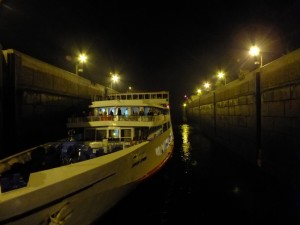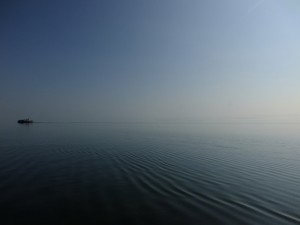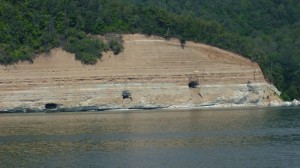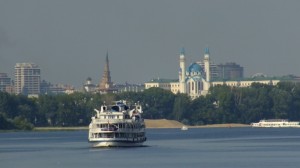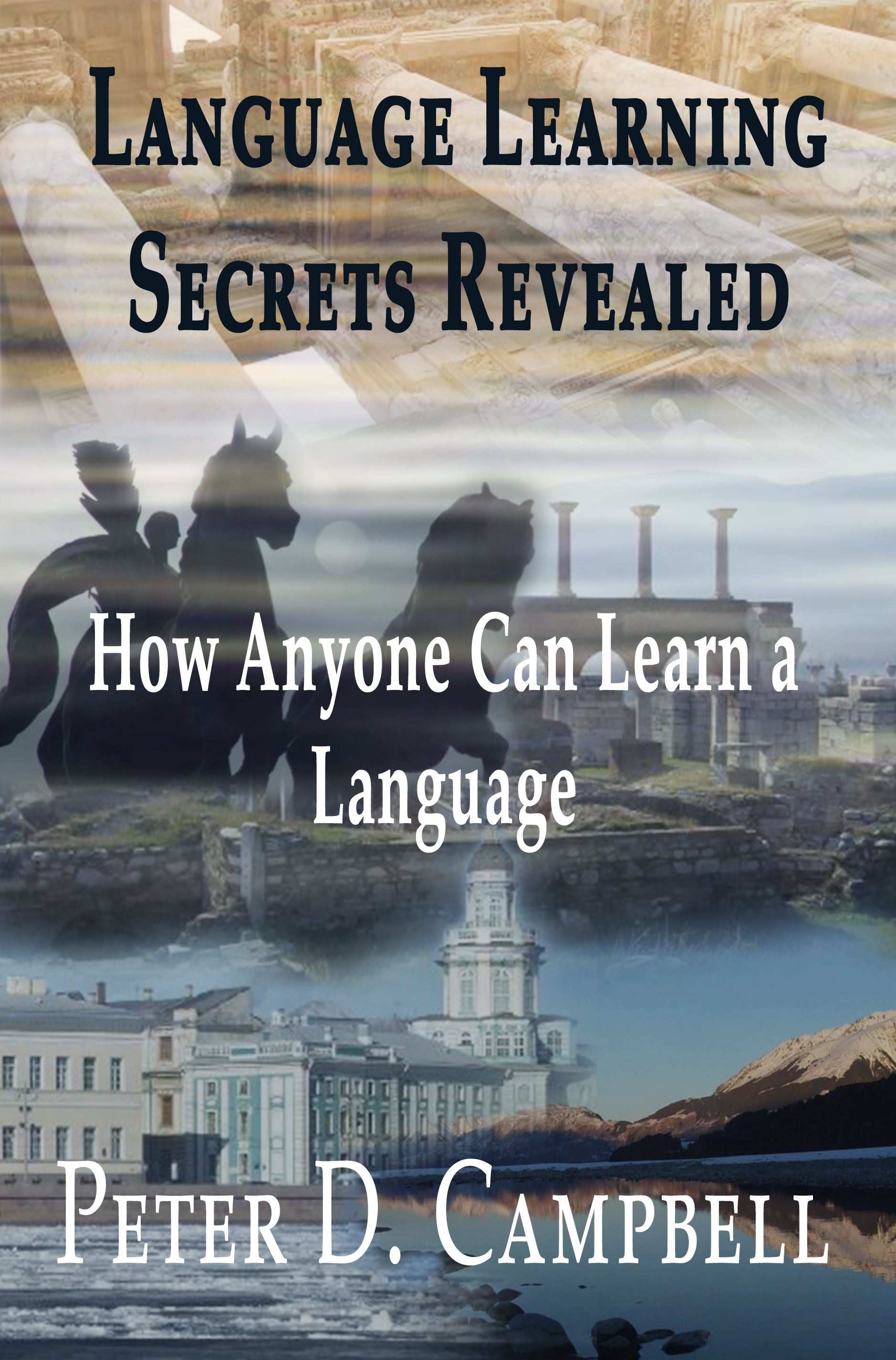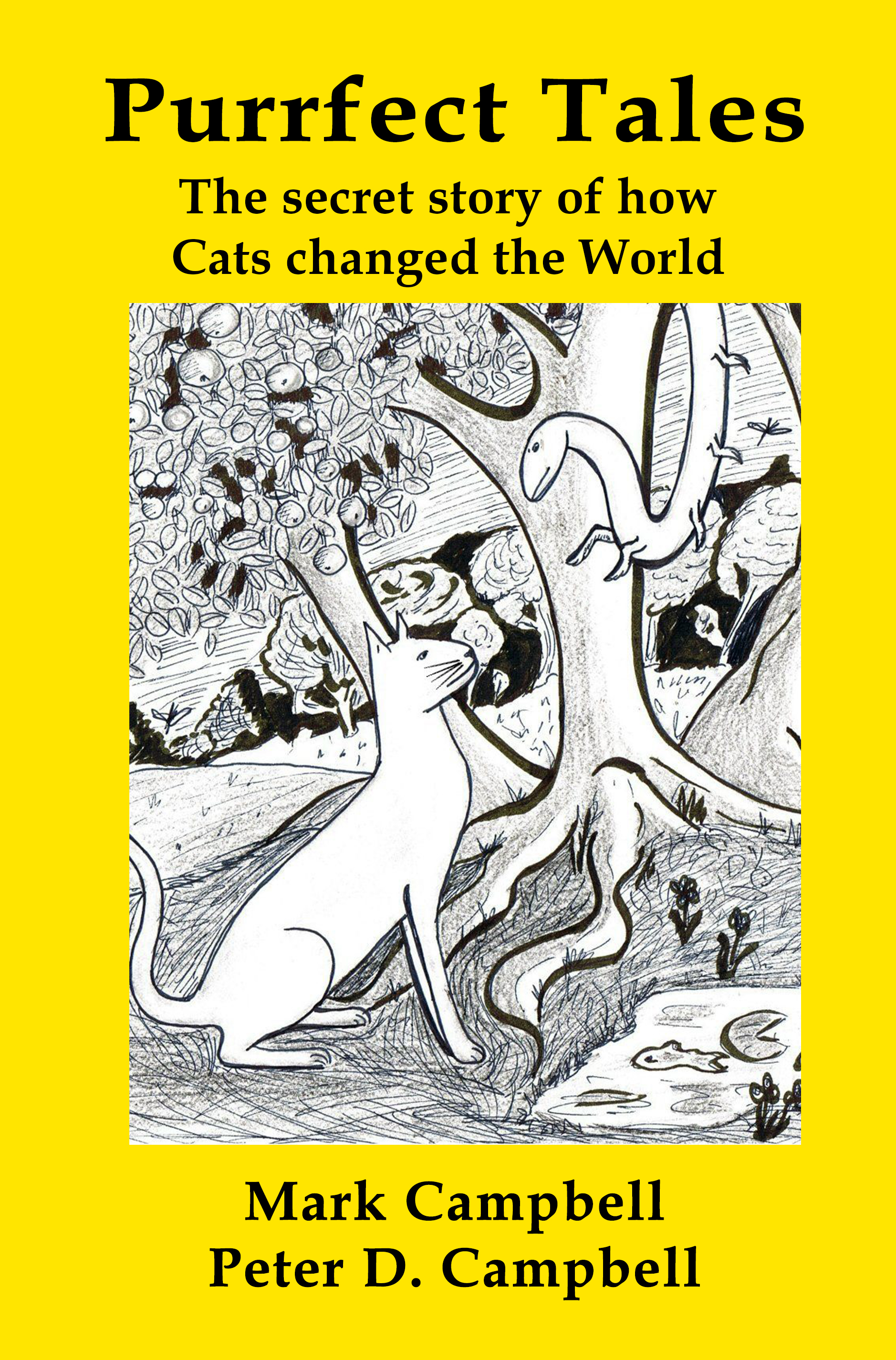The glazed surface of water reaches into the distance. A faint haze obscures the horizon and the sky melds with the water. It gives a strange sensation, as if you are encapsulated and isolated in a world of stillness. The water is calm and the sun burns overhead. I could be in the doldrums in the middle of the Pacific Ocean. I am instead on the Volga River – the largest river in Europe.
The Volga River rises northwest of Moscow and meanders in an easterly direction until it heads south to the Caspian Sea. The river has played in important role in the development of Russian trade and has been an important strategic location throughout Russia’s history – and is perhaps responsible for the direction of Russian expansion – Russia expanded first down the Volga, then east to protect the Volga.
I had departed Samara the previous evening at 8pm as the sun dipped beneath the horizon. As we pulled away from the berth the MC gave instructions for us to release our “magical balloons”, filled with helium and make a wish – a slightly different approach to wishing upon a star – and some 100 balloons rushed from the upper deck into the darkening sky.
I sat on the deck as darkness fell and watched the banks as they slowly faded into darkness. On the right the tightly packed buildings of Samara gave way to parks on the city’s outskirts, littered with buildings belonging to the city’s and Russia’s elite with direct, private access to the Volga. On the left, the occasional light revealed a dacha or a summer camp – many camps have been established as getaway resorts on the edge of Russia’s main city.
The light haze that hung in the distance throughout the day turned to a denser fog as we sailed deeper into night. After a couple of hours we reached the gap in the Zhiguli Mountains. A mountain range of some 70km, split in two by the Volga. A geological mystery – it is the source of local folklore. Recent folklore uses the foolproof explanation for anything unusual – namely that aliens are responsible. Traditional folklore resorts to a more typical explanation – involving two brothers, women and a dog.
Two brothers, Sokol and Zhigul, fought an ongoing war with the Volga which constantly raided their land, sending her agents, waves, on sorties. But the brothers were guarded by Sokol’s dog who barked every time Volga approached, for Sokol feared the river for she was cunning and ever sought wide spaces and the most direct route to the sea.
Each time the Volga approached the brothers awoke and fought her until the waves fell back in their channel.
Sokol loved beautiful women… loved to bear them on his broad shoulders and would delight them by growing flowers of all colours and sprouting alleys of trees. And when these beauties approached and the dog began barking, Sokol would beat the dog so that the dog would not drive away these beautiful women. And so it was that the dog came to fear beauties lest Sokol should beat him.
One day the Volga learnt of Sokol’s love for beautiful women. She dressed as a beauty and approached. The dog stayed silent and Volga seeing the brothers enchanted by her beauty filled her breast to prepare for the attack and struck the brothers. The blow was so mighty that it broke the brothers apart and threw them in different directions. The dog had only just enough time to bare his teeth and bark. The barks reached Sokol, who was petrified by the sound, while the dog was struck by a blow from the mighty Volga and carried away, while the river laughed and roared sweeping between the two brothers to the sea.
Various entertainments were available onboard. From the rear of the ferry, music blared from a small disco which was being held, mimicking the famed discos which are held on the ferries to Sweden. As the majority of people on the boat were pensioners, the disco seemed out of place. In the bow a movie was being shown on a medium sized television.
I turned in to sleep and felt the change in the tone of the engines as the river broadened and the vessel contended with more currents. Later the boat came to a halt and going on deck I found that we had reached a huge lock which contained another cruise boat behind ours. The locks are 200m by 30m. The Volga is Russia’s lifeline. Eleven of Russia’s 20 major cities are located on the river. It is a major producer of grain and hydro-electricity. Consequently, the river is covered in dams used for irrigation and power generation.
With the lock gates closed the water level rose quickly but imperceptibly until the final couple of metres where the water flooded in and the cruise ships rose to the level of the upper reservoir within a minute or so. The gate opened and the ferry chugged forwards into another watery expanse.
Faint lights shone through the fog showing a shore about a kilometre away. I looked into the sky hoping to see the Pleiades meteor shower which was promised in Facebook last week, but a combination of haze and light pollution from neighbouring cities gave me only a vague view of the sky. I went back to bed and slept to morning – awakening once to the sound of another lock.
The sun was already blazing high in the sky when I came on deck at 8am. Impressive in size and volume, it is this which makes the Volga less interesting to cruise than other smaller rivers, for the scenery rarely changes.
The region itself is fascinating – having been the home of various ethnic groups as they migrated from Central Asia to Europe. It is thought that the Volga River was the home to proto Indo-European culture.
The region was originally settled by Finnic-Ugrians (a linguistic group still seen today in Finland, Estonia and Hungary). These were then displaced by the Scythians – a Turkic people who moved into Russia and Ukraine in about the seventh century BC and spread throughout southern Russia from the Ukrainian steppes to the Altai mountains. The Scythians are mentioned in Herodotus’ Histories and he mentions the Scythian name for the Volga, Rha, meaning “wetness” which is the derivation for the Slavic name, Volga, the route of the contemporary Russian word vlazhnost’ meaning “moisture”. In about the second century AD the Scythians were displaced from the region by another Turkic people – the Bulgars.
The Bulgars got caught up with the Hunnic migrations – with some staying along the Volga River and others moving west with the Huns. After Attila’s defeat against Rome in 453 AD, the Bulgars withdrew east and established a confederation with the local Slavic population, adopting the local language. This population may have been supported by an additional Bulgar migration in the seventh century. It was this confederation that led to the rise of Bulgaria which for a couple of hundred years played an important role to the north of the Byzantine Empire.
Back on the Volga River, the Bulgars became involved in trade and converted to Mohammedanism in 922/3 AD. This led to increased Islamic influences in the region with the construction of additional fortresses and mosques. When Vladimir I of Kiev wanted a new religion for his nation, Volga Bulgaria attempted to convert him to Islam. Despite being apparently interested by Islam, Vladimir balked at the idea of banning wine which would take away the very joy of his people’s lives.
Under the Volga Bulgarians trade was conducted up the Volga River, uniting Europe with the Orient. This continued until the Crusades when more direct routes became available. The Crusades probably started the beginning of the decline of Volga Bulgaria which was hastened by the arrival of Genghis Khan. In 1223, an advance party led by Uran invaded the region but was defeated by the local Bulgarians at the Battle of Samara Bend. In 1236 the Mongols returned and over a five year period conquered the region and killed up to 80 per cent of the local population. The Mongols established the khanates of Kazan and Astrakhan which remained until Ivan the Terrible captured them in the mid 16th century.
Much of the archaeological and historical evidence from the Volga’s past has been drowned by the numerous dams constructed along the length of the river during the 20th century.
Rounding the point of Kamskoe Uste, where the Volga is joined by the Kama River and is at its broadest point, the cruise ship pushed forwards into a narrower section of the Volga, keeping the left bank within a couple of hundred metres, the right bank was again largely concealed by haze with the width ranging in distance from two to six kilometres.
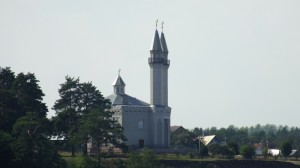 We passed the occasional settlement. Then as the day progressed and we approached Kazan these settlements became larger. Occasionally we passed Orthodox churches, sometimes passed Mosques. The region has a strong Muslim influence as a result of the Tartars who came to the region with the Mongols. However, after the taking of Kazan and Astrakhan in the 15th century, Ivan the Terrible sent large numbers of Russians to the area and supported the construction of churches. Laws were also passed to ensure only Christians could hold positions of authority in Kazan. As a result of these policies, Orthodoxy was introduced into a region which had only ever been pagan or Islamic. Today the Orthodox influence is still strong in the region today.
We passed the occasional settlement. Then as the day progressed and we approached Kazan these settlements became larger. Occasionally we passed Orthodox churches, sometimes passed Mosques. The region has a strong Muslim influence as a result of the Tartars who came to the region with the Mongols. However, after the taking of Kazan and Astrakhan in the 15th century, Ivan the Terrible sent large numbers of Russians to the area and supported the construction of churches. Laws were also passed to ensure only Christians could hold positions of authority in Kazan. As a result of these policies, Orthodoxy was introduced into a region which had only ever been pagan or Islamic. Today the Orthodox influence is still strong in the region today.
As we neared Kazan the sides of the river became more heavily populated and the city slowly came into view through the haze with the kremlin sitting on the highest point overlooking the river.
The vessel berthed and while the other tourists went off for a three hour excursion, I called a taxi and went to a local hotel where I was to spend the next two days exploring the capital of the Kazan Khaganate and modern day Tatarstan – a mix of Orthodox Christianity, Islam and Europe, creating a vibrant culture and exciting city.
If you like Intrepid Adventure and our articles, subscribe to our site and share each article in Facebook so that others can enjoy reading them too.
Be sure to like Intrepid Adventure on Facebook and check out Peter Campbell’s latest books on Amazon.com.
Copyright © Peter Campbell 2014, www.intrepid-adventure.com


